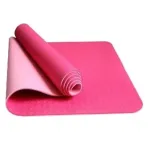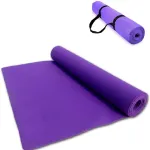Specialized Yoga Mats for Different Practices
Yoga mats are designed to cater to specific types of yoga and fitness practices. Below are some common types of yoga mats based on the type of practice:
1. Travel Yoga Mats
Travel yoga mats are lightweight and thin, making them easy to pack and carry. They are typically 2-3mm thick and offer minimal cushioning but excellent portability. These mats are ideal for people who practice yoga while traveling or attending classes outside their home. Some travel mats are foldable, allowing them to fit into a suitcase or backpack.
2. Hot Yoga Mats
Hot yoga mats are designed to provide extra grip and moisture-wicking properties for practices in heated environments. Cork and rubber mats are popular choices for hot yoga as they offer excellent grip, even when wet. Some mats come with a built-in towel layer that absorbs sweat and enhances traction.
Select the color
Select Variant
Select quantity
Introduction to Yoga Mats: Essential Fitness Gear
Yoga mats have evolved into a vital piece of fitness equipment for a variety of exercises, from yoga to Pilates and general workout routines. They are designed to provide comfort, support, and stability, making exercises more effective and enjoyable. A well-made yoga mat enhances the overall workout experience, prevents injuries, and supports the body in achieving balance during different poses. In this comprehensive article, we will explore the history, features, and various uses of yoga mats, with a special focus on eco-friendly, durable, and performance-oriented options.
Historical Background and Evolution
The origins of yoga can be traced back to ancient India, where practitioners performed yoga on natural surfaces such as grass, dirt, or wooden floors. Over time, as yoga spread to other cultures and societies, the need for a specialized surface became evident. Early yoga mats were crafted from animal skins, such as deer or tiger skins, which were considered sacred in India. These natural mats provided a certain level of cushioning and grip but were not practical for long-term or hygienic use.
The modern yoga mat as we know it today was introduced in the 20th century. In the 1960s, as yoga gained popularity in the West, practitioners started using foam mats to provide comfort and grip during poses. Angela Farmer, a renowned yoga teacher, is credited with inventing the first commercially available "sticky" yoga mat in the 1980s. Made from PVC (polyvinyl chloride), this mat offered excellent grip, making it easier to maintain balance in various yoga postures.
Since then, yoga mats have continued to evolve. Today, a wide range of materials, textures, and thickness options are available, catering to different types of workouts and user preferences. The growing demand for eco-friendly and sustainable products has also led to the development of mats made from natural and recyclable materials such as rubber, cork, and jute.
Types of Yoga Mats Based on Material
Yoga mats are made from various materials, each with its own benefits and drawbacks. Below are some common types of yoga mats categorized by material:
1. PVC Yoga Mats
PVC yoga mats, often referred to as "sticky mats," are one of the most popular options due to their excellent grip and durability. They are lightweight, affordable, and provide sufficient cushioning for most users. However, PVC is not eco-friendly as it is derived from plastic, and the production process can release harmful chemicals. PVC mats are ideal for people who prioritize comfort, grip, and affordability.
2. Rubber Yoga Mats
Rubber yoga mats are made from natural or synthetic rubber, providing a balance between grip, cushioning, and sustainability. Natural rubber is biodegradable, making these mats an eco-friendly alternative to PVC mats. They offer excellent traction, even when wet, making them ideal for hot yoga or high-intensity workouts. Rubber mats are slightly heavier than PVC mats and may have a distinct odor initially, but this fades with use.
3. Cork Yoga Mats
Cork yoga mats are made from sustainably harvested cork and are renowned for their natural anti-microbial properties, which help to prevent the growth of bacteria and odors. Cork mats offer excellent grip, especially when moist, making them ideal for hot yoga. They are also lightweight and durable, but they tend to be more expensive than other options. These mats are perfect for environmentally conscious users who want a high-performance mat that is also sustainable.
4. Jute Yoga Mats
Jute yoga mats are made from natural jute fibers, a sustainable and biodegradable material. They provide a natural, earthy feel underfoot and offer decent grip, although they may not be as sticky as PVC or rubber mats. Jute mats are best suited for gentle yoga practices or meditation rather than high-intensity or fast-paced workouts. Their eco-friendliness and aesthetic appeal make them a popular choice for those looking for a natural alternative.
5. TPE Yoga Mats
Thermoplastic Elastomer (TPE) yoga mats are made from a blend of plastic and rubber materials. They are considered an eco-friendlier alternative to PVC mats, as they are recyclable and non-toxic. TPE mats offer good grip, cushioning, and are lightweight, making them a versatile option for various types of yoga. However, their durability may not be as high as rubber or PVC mats, and they can wear out with extended use.
Key Features to Consider When Choosing a Yoga Mat
Choosing the right yoga mat depends on several factors, including material, thickness, texture, and portability. Here are some key features to consider:
1. Thickness and Cushioning
The thickness of a yoga mat plays a significant role in determining the level of comfort it provides. Standard yoga mats are around 4-6mm thick, offering a good balance between cushioning and stability. Thicker mats (8-12mm) provide more cushioning and are suitable for people with sensitive joints or those practicing restorative yoga. However, thicker mats may sacrifice some stability, making balancing poses more challenging.
Thinner mats (2-3mm) are more portable and provide better ground contact, making them ideal for travel or practices that require strong stability, such as Ashtanga yoga. The choice of thickness ultimately depends on the user's personal preferences and the type of yoga they practice.
2. Texture and Grip
The texture of a yoga mat affects its grip and the amount of traction it provides. Mats with a sticky surface or textured pattern offer better grip, which helps prevent slipping during poses. PVC mats are known for their excellent stickiness, while cork and rubber mats provide grip through their natural textures. Textured mats are especially useful for hot yoga or high-intensity workouts where sweat may reduce traction.
Smooth mats, on the other hand, offer a softer feel and are better suited for slow, meditative practices. The level of grip needed depends on the user’s practice style, as well as the conditions in which they practice.
3. Portability
Portability is a crucial consideration for those who travel frequently or attend yoga classes outside of their home. Lightweight mats (usually around 2-3mm thick) are easier to carry and transport but may provide less cushioning than thicker mats. Many yoga mats come with carry straps or can be rolled up compactly for easy portability.
Heavier mats, such as rubber or thick cushioned mats, may offer better durability and support but are less convenient to transport. Users who practice yoga at home may prioritize comfort and durability over portability.
4. Eco-Friendliness
As environmental consciousness grows, many practitioners are opting for eco-friendly yoga mats made from sustainable, biodegradable, or recyclable materials. Mats made from natural rubber, cork, or jute are excellent choices for eco-conscious users. TPE mats are another option as they are non-toxic and recyclable, although they are less durable than natural materials.
PVC mats, while durable and affordable, are not eco-friendly, as their production releases harmful chemicals and they do not biodegrade easily. When choosing a yoga mat, it's essential to consider its environmental impact and opt for a product that aligns with your values.
Specialized Yoga Mats for Different Practices
Yoga mats are designed to cater to specific types of yoga and fitness practices. Below are some common types of yoga mats based on the type of practice:
1. Travel Yoga Mats
Travel yoga mats are lightweight and thin, making them easy to pack and carry. They are typically 2-3mm thick and offer minimal cushioning but excellent portability. These mats are ideal for people who practice yoga while traveling or attending classes outside their home. Some travel mats are foldable, allowing them to fit into a suitcase or backpack.
2. Hot Yoga Mats
Hot yoga mats are designed to provide extra grip and moisture-wicking properties for practices in heated environments. Cork and rubber mats are popular choices for hot yoga as they offer excellent grip, even when wet. Some mats come with a built-in towel layer that absorbs sweat and enhances traction.
3. Alignment Yoga Mats
Alignment yoga mats feature printed guides or lines that help practitioners maintain proper body alignment during poses. These mats are beneficial for beginners or anyone looking to improve their form and posture. The printed lines act as visual cues, making it easier to position the body correctly during different asanas.
4. Extra-Thick Mats for Meditation and Restorative Yoga
Extra-thick mats (8-12mm) are designed for restorative yoga, meditation, or practices that require long periods of sitting or lying down. These mats provide ample cushioning, making them ideal for people with joint issues or those looking for added comfort during their practice. However, they may not offer the same level of stability as thinner mats.
Maintaining and Cleaning Your Yoga Mat
Proper maintenance and cleaning are essential to prolong the life of your yoga mat and ensure a hygienic practice. Regular cleaning prevents the buildup of sweat, dirt, and bacteria, which can cause odors and reduce the mat's lifespan.
Most yoga mats can be cleaned with a simple solution of water and mild soap. After cleaning, mats should be air-dried completely before rolling them up for storage. Cork and rubber mats may require special care, as harsh cleaning agents can damage the material. It is recommended to clean mats after each use, especially if they are used in hot yoga or high-intensity workouts.
Conclusion: Finding the Perfect Yoga Mat for Your Practice
Choosing the right yoga mat is a personal decision that depends on your specific needs, preferences, and the type of yoga or workout you practice. With a wide variety of materials, thicknesses, and features available, there is a yoga mat for everyone. Whether you prioritize eco-friendliness, portability, or cushioning, understanding the different types of yoga mats and their features can help you make an informed choice. Investing in a high-quality yoga mat will not only enhance your practice but also contribute to your overall well-being.
| Product Name | InStock | Item Weight( Kg ) | Pieces in Pack | Carton Weight ( Kg ) | Carton Size ( Cm ) |
| Yoga Mat In Pouch SKU: EL-YM-30 | 12 | 0.0000 | 12 | 13.4000 | 51.5x41x67 |
| Yoga Mat In Pouch SKU: EL-YM-30-PR | 12 | 0.0000 | 12 | 13.4000 | 51.5x41x67 |
| Yoga Mat In Pouch SKU: EL-YM-30-BK | 12 | 0.0000 | 12 | 13.4000 | 51.5x41x67 |








